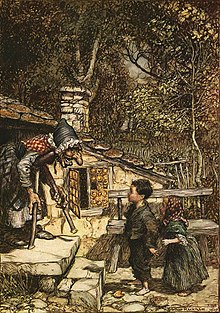German folklore
This article needs additional citations for verification. (April 2024) |

German folklore is the
Characteristics
It shares many characteristics with
As in Scandinavia, when belief in the old gods disappeared, remnants of the
- Frau Holle or Perchta, a "supernatural" patron of spinning and leader of the Wild Hunt (in German folklore preceded by an old man, Honest Eckart, who warns others of its approach) or of the Heimchen
- solitary wild huntsmen such as the ewiger Jäger or the Türst
- the Lorelei, a dangerous Rhine siren derived from 19th-century literature, among other nixies such as the Rhinemaidens
- the Weiße Frauen and Witte Wiwer, white female spirits
- the Doppelgänger, supernatural beings said to resemble the exactly similar appearance of determined person
- the giant Rübezahl
- the mining sprite Bergmönch
- wood sprites such as the tiny Moss people and their matriarch Buschgroßmutter, or the man-eating Fänggen
- nightmare-causing Alp, mare, and Drude
- the banshee Klagmuhme
- undead Nachzehrer and Wiedergänger
- ghostly Feuermann, Hemann, and Uhaml
- changeling legends
and many more generic entities such as the
There further are mythical animals such as Bahkauv, Beerwolf, Elwetritsch, Erdhenne, lindworm, Nachtkrapp, Rasselbock, Tatzelwurm, and Wolpertinger, or mythical plants such as Alraune and Irrwurz.[citation needed]
Popular folklore includes
Character folklore includes the stories of the Pied Piper of Hamelin, the Godfather Death, the trickster hero Till Eulenspiegel, the Town Musicians of Bremen and Faust.
History
Documentation and preservation of folklore in the states that formally united as
Study was further promoted by the
Some of the works of
Within Germany, the nationalistic aspect was further emphasized during the
See also
References
- JSTOR 40600558.
External links
- Johann Karl August Musäus Projekt Gutenberg DE (in German)
- German Fairy Tales and Folklore Collected by Fairytales (in English)
